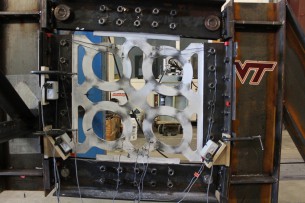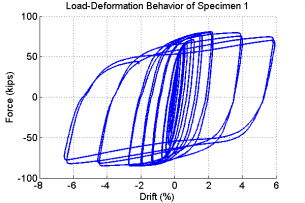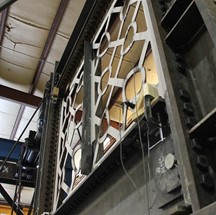Nov 2012
Ring-Shaped Steel Plate Shear Walls
The ring-shaped steel plate shear wall (RS-SPSW) builds on the advantages of conventional solid steel plate shear walls, but has improved seismic performance, reduced demands on boundary elements, and allows simple shear beam-to-column connections. The RS-SPSW consists of a SPSW in which the steel web plate is cut with a pattern of holes leaving ring-shaped portions of steel connected by diagonal links. The ring shape resists out of plane buckling through the mechanics of how a circular ring deforms into an ellipse. It has been shown analytically, through prior experimentation, and finite element analysis that the ring’s compression diagonal will shorten a similar amount as the tension diagonal elongates. Essentially, the slack is removed in the direction perpendicular to the tension field thus resisting the tendency for the plate to buckle out of plane. Because of the unique features of the ring’s mode of distortion, the load-deformation response of the resulting RS-SPSW system can exhibit full hysteretic behavior. Reduced buckling also leads to greatly improved stiffness. Improved energy dissipation and stiffness make the moment connections that are required for conventional SPSW unnecessary. Furthermore, through the introduction of more design variables associated with the geometry of the rings, it is possible to separately tune the strength, stiffness, and ductility of the RS-SPSW system.
We investigated the ring-shaped steel plate shear wall with small-scale experiments, large-scale experiments, finite element analyses and full-building analyses subjected to earthquake ground motions.
An example of the small scale tests (Egorova et al. 2014). Want to see a video of the test? Click Here!

An example of the large scale tests (Phillips and Eatherton 2018). Want to see a video of the test – Click Here!
Phillips, A.R., and Eatherton, M.R. (2018) “Large-Scale Experimental Study of Ring Shaped-Steel Plate Shear Walls” Journal of Structural Engineering, Vol. 144, No. 8, pp. 1-13.
Phillips, A.R. and Eatherton, M.R. (2018) “Computational Study of Elastic and Inelastic Ring Shaped – Steel Plate Shear Wall Behavior”, Engineering Structures, Vol. 177, pp. 655-667
Phillips, A.R. (2016) Large-Scale Cyclic Testing and Development of Ring Shaped-Steel Plate Shear Walls for Improved Seismic Performance of Buildings, Ph.D. Dissertation, Virginia Tech
Egorova, N., Eatherton, M.R., and Maurya, A. (2014) “Testing of Ring-Shaped Steel Plate Shear Walls that Resist Buckling for Improved Seismic Performance” Journal of Constructional Steel Research, Vol. 103, pp. 179-189.
Egorova, N. (2013) Experimental Study of Ring-Shaped Steel Plate Shear Walls, M.S. Thesis, Virginia Tech
Maurya, A. (2012) Computational Simulation and Analytical Development of Buckling Resistant Steel Plate Shear Wall (BR-SPSW), M.S. Thesis, Virginia Tech
More Research:
- Buckling Restrained Brace Subassemblage Testing
- Testing of Steel Crates
- Development of a Spectral Matching Algorithm
- End-Plate Moment Connections
- Self-Centering Beams for Resilient Earthquake Resistance
- Super High Tension Bolts
- Effect of Fasteners and Defects in the Protected Zone on the Performance of Moment Frames
- Controlled Rocking of Steel Braced Frames with Replaceable Energy Dissipating Fuses
- Development of a Self-Centering Buckling Restrained Brace
- Understanding Structural Response During Earthquakes Using Wavelet Transforms
- Characterizing Hysteretic Behavior of Cold-Formed Steel Members and Connections


